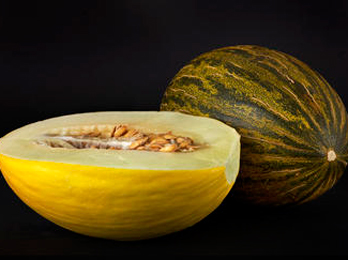Melon Genome Obtained

03/07/2012
A consortium of nine public and private research centres obtains the melon genome, a fruit species with one of the greatest economic values in the world. It is the first time that an initiative uniting private and state-run centres in Spain obtains the complete genome of a higher organism, in this case a plant, which produces flowers and seeds. This has been done by applying massive sequencing technologies, which are cheaper and more efficient.
In addition to the full melon genome, researchers were able to sequence the particular genomes of seven different varieties. The study was published in the Proceedings of the National Academy of Sciences (PNAS).
The scientific project was led by Pere Puigdomènech of the Spanish National Research Council (CSIC), and Jordi Garcia Mas of the Institute for Research and Technology in Food and Agriculture (IRTA). Both scientists work at the Centre for Research in Agricultural Genomics (CRAG) of Universitat Autònoma de Barcelona. The team lead by Roderic Guigó of the Centre for Genomic Regulation (CRG) also made important contributions to the project.
The Melonomics Project, launched by the Spanish Genome Foundation, included the participation of nine centres of research and the support of five firms and five Spanish autonomous communities.
Results show that the melon genome has 450 million base pairs and 27,427 genes. It is much larger than the genome of its nearest "relative", the cucumber, which has 360 million base pairs. ?This difference is due mainly to the amplification of transposable elements. We did not find recent duplications within the genome, which are very common in plant species?, highlights Puigdomènech.
?We have identified 411 genes that can be related to disease resistance. They are few but, even so, the melon has a high capacity of adapting to different environments?, Puigdomènech explains. During the study, when comparing this genome with others that are phylogenetically near, researchers observed how changes occur in the genome of this species, which is known for its high variability.
Another interesting aspect of the study is related to the ripening of the fruit, a process which determines characteristics such as taste and flavour. Scientists identified up to 89 genes related with some aspects of this process: 26 genes related to the carotenoid accumulation - which gives colour to the melon flesh - and 63 related to the sugar accumulation and the melon's flavour. Twenty-one of these 63 genes had never been described before.
?Knowing the genome and the genes related to the characteristics of value for agriculture will allow us to improve this species and obtain more disease resistant varieties with better organoleptic properties?, points out IRTA researcher Jordi Garcia Mas.
Melon, Cucumber, Watermelon, Pumpkin and Squash
Melon belongs to the family of cucurbits, which also includes species such as the cucumber, watermelon, pumpkin and squash. Cucurbits have relatively small genomes. ?These are species of high economic interest, especially in the Mediterranean, Asian and African countries. Diseases that affect them, such as the mosaic virus in the case of cucumber or fungi can cause high losses. Therefore, we hope the genome sequencing will have an important impact on improving this crop?, says Pere Puigdomènech.
According to 2009 figures from the Food and Agriculture Organization (FAO) of the United Nations, the production of melon worldwide is 26 million tonnes every year. Spain is the fifth biggest producer in the world. Approximately a third part of the production is exported, which makes Spain the largest exporter of melon.
A Collaborative Project of Many Partner Institutions
The melon genome project has been led by the Centre for Research in Agricultural Genomics (CRAG), which is a consortium of different institutions and universities and where they have sequenced and assembled the genome, in collaboration with the Centre for Genomic Regulation in the annotation of the genome.
The project also included the collaboration of the Pompeu Fabra University (Barcelona), the CSIC Centro de Edafología y Biología Aplicada del Segura (Murcia), the Centre Nacional d?Anàlisi Genòmica (Barcelona), the Technical University of Valencia and the University of Wisconsin-Madison (US). The company Roche Diagnostics also facilitated technologies in order to help in the genome assembling.
The project, with a budget of over 4 million Euros, received the financial support of the Spanish Genome Foundation, of five Autonomous Communities - Andalusia, Castilla La Mancha, Catalonia, Madrid and Murcia - and of the companies Semillas Fitó, Syngenta Seeds, Roche Diagnostics, Savia Biotech and Sistemas Genómicos.